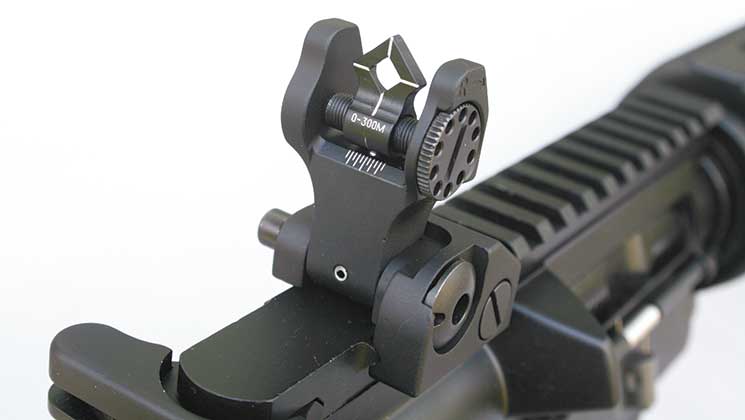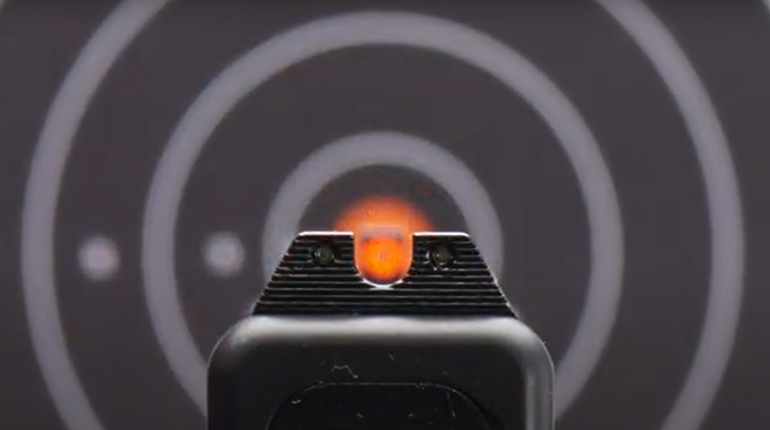
There is a saying that “Two is one and one is none.” Essentially, this means any must-have tool or firearm should be backed up with some kind of redundancy. Cops carry a second handgun to complement their primary. Military operators generally back up their rifle or carbine with a pistol. Now, shooters are equipping backup iron sights (BUIS) on their AR-15 rifles.
During the last few years, optical sighting systems have moved from unique accessory to stock item on the modern battle rifle and carbine. They vary from 1X red-dot types to low-power (3-4X) magnification models. And they are typically more compact than traditional high-powered riflescopes.
The old-school detractors of these new gee-whiz optics generally have two arguments against them. Argument No. 1 is that they are electronic and run on batteries. The electronics can break or the batteries will die right when you need them, they say. Argument No. 2 is similar. The naysayers point out the optics are made of glass and glass can break or crack, leaving you with no sighting system.
As an answer to these concerns, the concept of backup iron sights was born. A front and rear iron sight set installed on the rifle or carbine as a redundant backup to the optical sight.
Backup iron sights came into vogue a few years ago, and numerous manufacturers began to produce sets of front and rear sights that fold down/flip up. It is worthwhile to consider some criteria for backup iron sights and how to use them properly.

The Basics of Backup Iron Sights
First and foremost, BUIS need to be made of durable material. Steel and aircraft-grade aluminum are the order of the day. If you are using backups in the event the optic becomes damaged, they need to be stout and able to withstand abuse.
Your backup sights should preferably fold down when not in use. Flipped up, they should lock firmly in place. Of course, if you have a standard “A-frame” front-sight housing, all you need is a rear backup sight.
Next on the checklist is the ability to adjust the sights for elevation and windage. Many sight sets have a front sight that adjusts for elevation and a rear sight that adjusts for windage. A few companies include both adjustments in the rear sight. Long-range sight adjustments are a bit optimistic, as the whole purpose of backup iron sights is to have them ready for common fighting distances.
The most important information is an understanding of how the sights adjust. Does the front sight have quarter turn, 1/4-MOA adjustments like an A2-style post, or is it a simple thread-in/thread-out like that of the AK-47? Does the rear sight have a 1/2- or 1/4-MOA windage adjustments, or something completely different? As far as the shape and style of the sights, it really comes down to Ford versus Chevy—a personal choice.

How to Zero Your Backup Iron Sights
Battle sight zero (BZO) is the process of adjusting your sights so you can hit a human-sized target from contact distance out to 200 or 300 yards. Most people, especially military personnel, BZO for 300 yards.
There are two schools of thought regarding BZO. The standard method is to ground or bench the rifle, then zero the sights at 25 yards. Conventional thinking is that the point of impact will be at the point of aim at both 25 and 300 yards.
Occasionally, I like to run the numbers. I used the 5.56 NATO M855 load as a test sample. This round fires a 62-grain projectile at approximately 2,900 fps from an M4-length barrel. To crunch the trajectory numbers, I used ballistic calculators from two different sources.
We will begin with the assumption that the offset from the bore to the tip of the front sight is 2.5 inches. With the rifle zeroed at 25 yards, the impact of the round at 100 yards will be 5.8 inches high. At 200 yards impact will be 9 inches high, and at 300 yards 6 inches high.
Using the same ammo and rifle stats, I calculated points of impact if you BZO at 30 yards. Impact will be 4.3 inches high at 100 yards, 6 inches high at 200 yards and a mere 1.6 inches high at 300 yards. A 5-yard difference in BZO does seem to matter. At 200 and 300 yards, it could be the difference between a hit and a near miss. I understand that all this math can be tedious, but stay with me for just one more paragraph.
If you zero your sights at 50 yards, the point of aim and point of impact at 200 yards are for all intents and purposes identical (on the calculator it’s a 0.2-inch difference). At 100 yards, the impact is only 1.4 inches high. The highest the round travels off line of sight is 1.6 inches at 125 yards. That is as close to dead on as you are going to get with this load and set-up. OK, no more numbers.

Co-Witnessing with Your Backup Iron Sights
The term “co-witness” means to align your backup iron sights with the reticle of your optical sight. Co-witnessing is only practical with non-magnifying optics. Magnified optics are a different ball game.
Unfortunately, some shooters believe co-witnessing means you only have to zero either the optic or the BUIS, not both. Generally, they will zero the BUIS, then install the optic and adjust the reticle to the tip of the front sight. This works for a rough zero, but it does not ensure your primary aiming device is dialed in. Remember, sights that are 2 or 3 inches off can be the difference between a hit or a miss.
The recommended method for co-witnessed BZO is to first sight in your backup iron sights and then fold them down. Install your chosen optic, and zero it with the identical load and at the same distance. Now, both are sighted in, and you are ready to rock.
There are a number of companies making quality BUIS, notably Troy Industries, Magpul and Yankee Hill Machine, among others. If you are going to use them as an emergency backup, your backup iron sights must be high quality. Cheap sights are just that—cheap. Like most things in life, you get what you pay for.
As far as which brand to choose, it is ultimately a personal decision. Keep in mind, any sighting system—be it glass or iron—is simply a tool designed to aid the shooter. Only through deliberate practice and training can you expect to achieve skill with arms.
A $500 optic backed up with a $100 set of iron sights is worthless in the hands of an untrained and unskilled shooter. Take the time to get professional training, and practice, practice, practice.




































